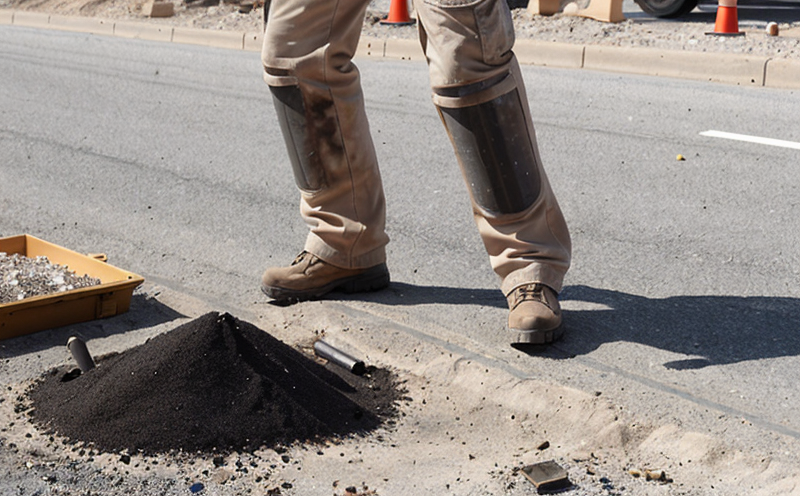EN 13631 Part 9 Determination of Sensitiveness to Friction
The Determination of Sensitivity to Friction (EN 13631-9) is a critical test in the mining sector that assesses the susceptibility of blasting materials and explosives to ignition by friction. This test is essential for ensuring safety during mining operations, as it helps identify potential hazards associated with the handling, storage, and transportation of these materials.
The frictional sensitivity test evaluates how easily an explosive or blasting agent can be ignited through friction-generated heat. The test involves applying controlled friction to a specified sample under defined conditions. The goal is to determine the minimum force required to ignite the material by measuring the energy output during this process.
This standard is particularly important in mining environments where the handling of explosives and blasting agents must comply with stringent safety regulations. For instance, it ensures that materials used in underground mines do not pose an unacceptable risk when subjected to frictional forces encountered during loading, unloading, or transport operations.
The testing procedure typically involves preparing a sample according to the specified dimensions and weight as outlined in EN 13631-9. The sample is then placed on a specially designed apparatus that simulates real-world friction conditions. The apparatus measures the force applied and the energy released during the test, which helps determine the sensitivity of the material.
Understanding the sensitiveness to friction is crucial for optimizing blasting operations while minimizing risks. This knowledge allows for the selection of safer materials and the implementation of appropriate safety protocols. In addition, it supports compliance with international standards such as EN 13631-9, which are designed to protect workers and the environment.
The test results provide valuable insights into the performance characteristics of blasting agents under controlled conditions. This information is vital for R&D engineers in developing new materials that meet stringent safety requirements without compromising effectiveness. Compliance officers can use these data points to ensure ongoing adherence to relevant regulations, while quality managers rely on consistent testing outcomes to maintain product integrity.
For procurement teams, understanding the friction sensitivity of blasting agents helps them select suppliers who adhere to high-quality standards and international best practices. This ensures that the materials they procure are not only safe but also reliable in diverse mining environments.
Scope and Methodology
| Parameter | Description |
|---|---|
| Test Specimen Preparation | The specimen should be prepared according to the dimensions specified in EN 13631-9. Typically, a sample of approximately 50 grams is used. |
| Friction Apparatus | A specially designed friction apparatus that applies controlled friction to the specimen. This apparatus is calibrated to ensure accurate measurements of both force and energy output. |
| Test Procedure | The test involves placing the prepared specimen on the friction apparatus and applying a constant force until ignition occurs or a predefined limit is reached. The energy released during this process is measured using sensors integrated into the apparatus. |
The methodology outlined in EN 13631-9 ensures that all tests are conducted under consistent conditions, allowing for accurate comparisons of different materials and their sensitivities to friction. This standardization is crucial for maintaining reliability and consistency across various testing facilities.
By following the prescribed procedures, laboratories can ensure that they are meeting the requirements set forth by international standards such as EN 13631-9. This not only enhances the credibility of test results but also facilitates better communication between different stakeholders involved in mining operations.
Environmental and Sustainability Contributions
The determination of sensitiveness to friction plays a crucial role in promoting sustainable practices within the mining industry. By identifying materials with high or low friction sensitivity, mines can adopt more efficient blasting techniques that reduce energy consumption and minimize environmental impact.
Incorporating this test into procurement processes helps ensure that only environmentally friendly materials are used, thereby reducing waste generation and improving overall sustainability performance. Additionally, compliance with international standards like EN 13631-9 demonstrates a commitment to responsible sourcing and operational excellence.
The results of the friction sensitivity tests contribute valuable data towards developing safer mining practices, which in turn supports broader efforts aimed at enhancing occupational health and safety within the sector.
Use Cases and Application Examples
| Use Case | Description |
|---|---|
| Blasting Agent Selection | Selecting blasting agents with appropriate friction sensitivity ensures safe handling during mining operations, reducing the risk of accidental ignition. |
| Operational Optimization | Understanding the sensitiveness to friction helps optimize blasting procedures by minimizing unnecessary energy expenditure and preventing potential safety hazards. |
| Safety Training | The results of this test contribute to comprehensive safety training programs aimed at educating personnel about the risks associated with handling highly sensitive materials. |
One notable application is in underground mines where frictional forces can be particularly high due to the nature of the environment. By identifying materials that are less prone to ignition by friction, miners can implement safer procedures and reduce the likelihood of accidents. This not only enhances operational efficiency but also contributes significantly to worker safety.
Another example is in large-scale mining projects where compliance with international standards like EN 13631-9 is mandatory. The test results provide assurance that all materials used meet stringent safety criteria, thereby supporting the broader goal of sustainable and responsible mining practices.





